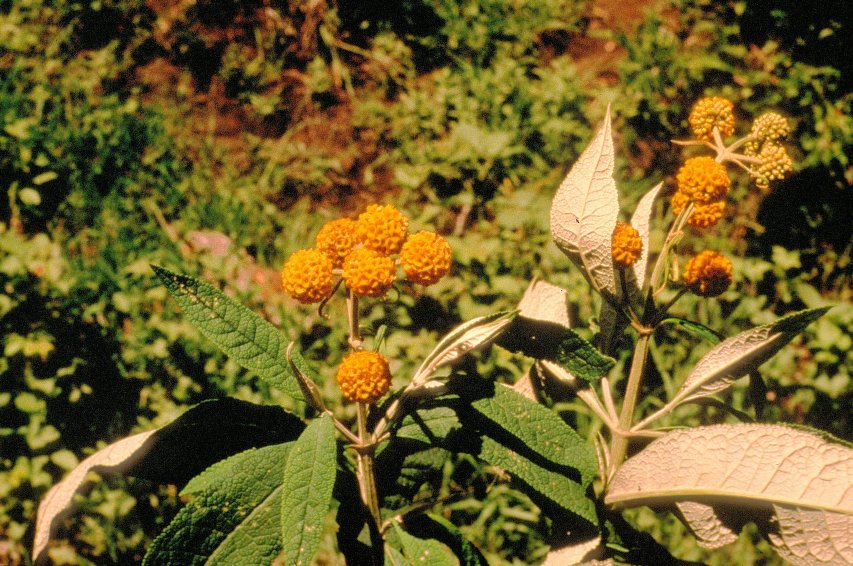Buddleja globosa Hope - Scrophulariaceae - matico, pañil (span.), orange ball tree, Kugel-Sommerflieder
Large shrub or small tree, up to 6m high, native to Argentina, Chile, Peru, cultivated as ornamental; leaves narrow-ovate or lanceolate, green and glabrous above, cream or yellowish and tomentose below; flowers fragrant, orange.
http://www.chileflora.com/Florachilena/FloraEnglish/HighResPages/EH0303.htm
„An aqueous extract of Buddleja globosa leaves, used traditionally in Chile for wound healing, was tested for the ability to stimulate growth of fibroblasts in vitro and for antioxidant activity in the same fibroblast cell system challenged with hydrogen peroxide. Low concentrations of the extract gave an increase in fibroblast growth which was not statistically significant but cytotoxicity was observed at concentrations greater than 50 μg/ml. The extract showed strong antioxidant effect and fractionation led to the isolation of three flavonoids and two caffeic acid derivatives, each of which was shown to contribute to the antioxidant effect at concentrations below 10 μg/ml. These activities would accelerate the healing of wounds.“
[Effects of Buddleja globosa leaf and its constituents relevant to wound healing., Mensah, A. Y., Sampson, J., Houghton, P. J., Hylands, P. J., Westbrook, J., Dunn, M., Cherry, G.W., Journal of Ethnopharmacology, 77(2), 2001, 219-226]
„A mixture of α- and β-amyrins was isolated from the hexane extract… Verbascoside and luteolin-7-O-glucoside were the major components of the methanol extract; apigenin 7-O-glucoside was also detected.“
[Analgesic, anti-inflammatory and antioxidant properties of Buddleja globosa, Buddlejaceae., Backhouse, N., Rosales, L., Apablaza, C., Goïty, L., Erazo, S., Negrete, R., Delporte, C., Journal of ethnopharmacology, Vol.116(2), 2008, 263-269]
„Leaf extracts of Buddleja globosa (Buddlejaceae) are used in Chilean folk medicine for wound healing… Seasonal influence was observed since autumn extract resulted less active. Extracts showed a dose-dependent antinociceptive activity in all assays, the highest effects were obtained for the formalin and writhing test. Verbascoside was more active than ibuprofen in the writhing test (67.6% and 50.0% at equimolar doses) and showed similar effects in the tail flick (topic and oral) near 25% at equivalent doses – ED25 or EC25 – to ibuprofen. Luteolin 7-O-glucoside was slightly more active in the tail flick test and nearly half active than verbascoside in the writhing assay. Effectiveness was higher for the sequential than for global alcoholic extracts, and can be increased by selective blocking of opioid receptors. Global methanol extract seems modulated only by naltrexone.“
[Antinociceptive activity of Buddleja globosa (matico) in several models of pain., Backhouse, N., Delporte, C., Apablaza, C., Farías, M., Goïty, L., Arrau, S., Miranda, H., Journal of ethnopharmacology, Vol.119(1), 2008, 160-165]
